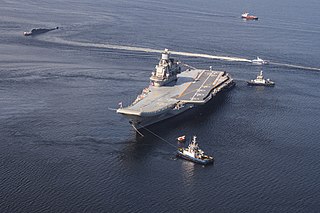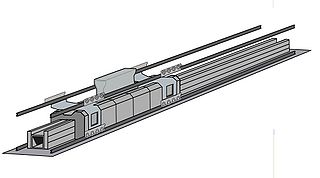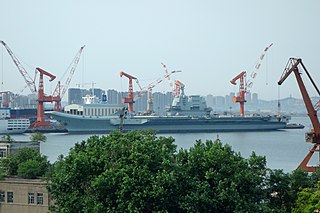
An aircraft carrier is a warship that serves as a seagoing airbase, equipped with a full-length flight deck and facilities for carrying, arming, deploying, and recovering aircraft. Typically, it is the capital ship of a fleet, as it allows a naval force to project air power worldwide without depending on local bases for staging aircraft operations. Carriers have evolved since their inception in the early twentieth century from wooden vessels used to deploy balloons to nuclear-powered warships that carry numerous fighters, strike aircraft, helicopters, and other types of aircraft. While heavier aircraft such as fixed-wing gunships and bombers have been launched from aircraft carriers, these aircraft have not successfully landed on a carrier. By its diplomatic and tactical power, its mobility, its autonomy and the variety of its means, the aircraft carrier is often the centerpiece of modern combat fleets. Tactically or even strategically, it replaced the battleship in the role of flagship of a fleet. One of its great advantages is that, by sailing in international waters, it does not interfere with any territorial sovereignty and thus obviates the need for overflight authorizations from third-party countries, reduces the times and transit distances of aircraft and therefore significantly increase the time of availability on the combat zone.

The Kuznetsov-class aircraft carrier, Soviet designation Project 1143.5, is a class of fixed-wing aircraft carriers operated by the Russian and Chinese navies. Originally designed for the Soviet Navy, the Kuznetsov-class ships use a ski-jump to launch high-performance conventional aircraft in a STOBAR configuration. The design represented a major advance in Soviet fleet aviation over the Kiev-class carriers, which could only launch VSTOL aircraft. The Soviet Union's classification for the class was as a heavy aircraft-carrying cruiser, which permits the ships to transit the Turkish Straits without violating the Montreux Convention, however the Chinese variants are classified as aircraft carriers.

The Gerald R. Ford class is a class of nuclear powered aircraft carriers currently being constructed for the United States Navy. The class, with a planned total of ten ships, will replace the Navy's current carriers on a one-for-one basis, starting with the lead ship, Gerald R. Ford replacing Enterprise (CVN-65), and then eventually taking the place of the existing Nimitz-class carriers. The new vessels have a hull similar to the Nimitz-class, but introduce technologies since developed with the CVN(X)/CVN-21 program, such as the Electromagnetic Aircraft Launch System (EMALS), as well as other design features intended to improve efficiency and reduce operating costs, including sailing with smaller crews. This class of aircraft carriers is named after former US President Gerald R. Ford. The first ship of the class, CVN-78, was procured in 2008 and commissioned into service on 22 July 2017. The second ship of the class, John F. Kennedy (CVN-79), is expected to be commissioned into service in 2024.

Ulyanovsk, Soviet designation Project 1143.7, was a fixed-wing aircraft carrier laid down on 25 November 1988 as the first of a class of Soviet nuclear-powered supercarriers. It was intended for the first time to offer true blue water naval aviation capability for the Soviet Navy. The ship would have been equipped with steam catapults that could launch fully loaded aircraft, representing a major advance over the Kuznetsov class, which could only launch high-powered aircraft from their ski-jumps. However, construction of Ulyanovsk was stopped at about 40% after the dissolution of the Soviet Union in 1991.

The Electromagnetic Aircraft Launch System (EMALS) is a type of aircraft launching system developed by General Atomics for the United States Navy. The system launches carrier-based aircraft by means of a catapult employing a linear induction motor rather than the conventional steam piston. EMALS was first installed on the lead ship of the United States Navy's Gerald R. Ford-class aircraft carrier, the USS Gerald R. Ford.
Project 1153 Orel was a late-1970s plan to give the Soviet Navy a true blue water aviation capability. The aircraft carrier would have about 72,000 tons displacement, with a nuclear power plant and about 70 aircraft launched via steam catapults, similar to the earlier Kitty Hawk-class supercarriers of the U.S. Navy. Unlike them and the preceding Soviet aircraft cruisers, it was also designed with a large offensive capability; the ship mounts including 24 vertical launch tubes for anti-ship cruise missiles. In the USSR it was classified as the "large cruiser with aircraft armament". The project 1153 was cancelled in October 1978 as being too expensive, and a smaller Project 1143.5, more V/STOL-aircraft-oriented, was developed instead: in its initial stage, a version of 65,000 tons and 52 aircraft was proposed, but the actual Kuznetsov-class aircraft carriers are even smaller, about 55,000 tons. While the Project Orel never saw fruition, in the 1980s it influenced the also abortive Ulyanovsk program.

USS Gerald R. Ford (CVN-78) is the lead ship of her class of United States Navy aircraft carriers. The ship is named after the 38th President of the United States, Gerald Ford, whose World War II naval service included combat duty aboard the light aircraft carrier Monterey in the Pacific Theater.

CATOBAR is a system used for the launch and recovery of aircraft from the deck of an aircraft carrier. Under this technique, aircraft launch using a catapult-assisted take-off and land on the ship using arrestor wires.

The People's Liberation Army Navy Surface Force is the surface warfare branch of China's People's Liberation Army Navy (PLAN), consisting of all surface vessels in operational service with the PLAN. The PLAN Surface Force operates 661 ships organized into three fleets: the North Sea Fleet, the East Sea Fleet and the South Sea Fleet.
Since the 1970s, China's People's Liberation Army Navy (PLAN) has had ambitions to develop and operate aircraft carriers, and since 1985 has acquired four retired aircraft carriers for study; namely, the British-built Australian HMAS Melbourne and the ex-Soviet carriers Minsk, Kiev and Varyag. The Varyag later underwent an extensive refit to be converted into the Liaoning, China's first operational aircraft carrier, which also served as a basis for China's subsequent design iterations. As of 2018, the PLAN has two combat-ready aircraft carriers, the Liaoning and Shandong, with the third under construction. It is projected that China may possess five or six aircraft carriers by the 2030s.
INS Vishal, also known as Indigenous Aircraft Carrier 2 (IAC-2), is a planned aircraft carrier to be built by Cochin Shipyard Limited for the Indian Navy. It is intended to be the second aircraft carrier to be built in India after INS Vikrant (IAC-1). The proposed design of the second carrier class will be a new design, featuring significant changes from Vikrant, including an increase in size and displacement. An Electromagnetic Aircraft Launch System (EMALS) CATOBAR system is also under consideration. Its name Vishal means 'giant' in Sanskrit.

INS Vikrant, also known as Indigenous Aircraft Carrier 1 (IAC-1), is an aircraft carrier constructed by the Cochin Shipyard Limited (CSL) for the Indian Navy. It is the first aircraft carrier to be built in India. It is named 'Vikrant' as a tribute to India's first aircraft carrier, Vikrant (R11). The name Vikrant means "courageous" in Sanskrit. The motto of the ship is "Jayema Saṁ Yudhi Spr̥dhaḥ", means "I defeat those who fight against me".
The Type 055 destroyer is a class of stealth guided missile destroyers being constructed for the Chinese People's Liberation Army Navy. It is a multi-mission design; the combination of sensors and weapons suggests a main role of area air defence, with anti-submarine warfare capabilities surpassing previous Chinese surface combatants.

Shandong is a Chinese aircraft carrier that was launched on 26 April 2017 for the People's Liberation Army Navy (PLAN) of the People's Republic of China. It is the country's first domestically built aircraft carrier and second in PLAN service after the completion and commissioning of Liaoning, from which it is derived. Shandong's class was initially suspected to be designated Type 001A but was revealed to be Type 002 at its commissioning ceremony. The class received the NATO reporting name Kuznetsov Mod. ("modified").
The Type 004 aircraft carrier is a planned aircraft carrier of the People's Liberation Army Navy's aircraft carrier programme. It is intended to be an iteration on the preceding Type 003 aircraft carrier, and like the Type 003, it will feature an integrated electric propulsion system that will allow the operation of electromagnetic launch catapults. Unlike the conventionally-powered Type 003, the Type 004 will be larger and also the first Chinese carrier to feature nuclear marine propulsion, and could generate enough electricity to power laser weapons and railguns currently under development. It is expected to be completed by the late 2020s, and up to four could be built.
Ma Weiming is a Chinese electrical engineer. He is a professor of the PLA Naval University of Engineering. He is an academician of the Chinese Academy of Engineering and holds the military rank of rear admiral. He led the development of the electromagnetic catapult system for the Type 003 aircraft carrier and the development of electromagnetic railguns. In 2017, he was awarded the Order of August First, the highest honour of the People's Liberation Army.
The Type 076 landing helicopter dock is a class of planned Chinese amphibious assault ship. Compared to the Type 075, the Type 076 is expected to have an electromagnetic aircraft catapult and arresting gear for operating fixed-wing aircraft, likely unmanned combat aerial vehicles (UCAV).
The Zhaotou class is a NATO reporting name of the ship class of patrol vessels of the China Coast Guard. It is the largest coast guard cutter in the world, surpassing the previous record holder, the Japanese Shikishima class.








